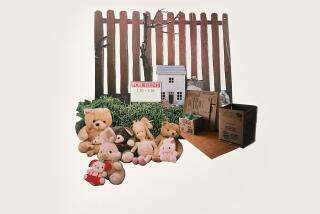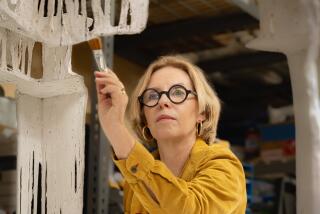Repairing a Work of Art Helps Weave the Strands of a Full Life
- Share via
Hermine Kazazian says she had only one goal in her 83 years--that her family would love one another.
From all appearances, she has achieved her goal. A day doesn’t pass without her husband, Nazaret, saying he couldn’t be where he is were it not for her. Her daughter-in-law, Marah, says she loves the older woman like her own mother.
The couple’s home in the Hollywood Hills is a long journey from Kazazian’s birthplace in Aleppo, Syria. Born to Armenian parents who had fled persecution in Turkish Armenia, she grew up surrounded with art. Her father, a postmaster, collected antiques and paintings. Each time a daughter was born he would buy a fine Persian rug, which was hers to take when she married. For his sons, he bought violins.
In 1915, the Kazazian home filled with refugees fleeing the massacre of Armenians by Ottoman troops. One of the refugees brought a contagious disease that killed Hermine Kazazian’s father. Five years later, her mother packed up her five children and went to live with relatives in Romania.
“For me it was fun,” said Kazazian, speaking Armenian as her daughter-in-law translated. “We lived with family for a year, and my older sister became a seamstress. Everybody helped. I learned how to sew.”
They started making rugs, and before long there was a family-owned factory. They prospered.
“Any money left over would be set aside for buying antiques,” Kazazian recalled.
The collection was valuable and the family was renowned in the cultural life of Romania.
Then came World War II and the Communist takeover. “When the Communists came, we had no choice--either donate our art to the government or it would be confiscated.”
The government relocated the collection to a museum on the first floor of a mansion and allowed the family to live on the top floor.
Life was hard. Kazazian married, and she and her husband supported five relatives on the money made from making rugs. The Communists eventually confiscated their factory and they became employees. Finally, in 1965, when restrictions were eased, Armenians could leave Romania but could take nothing with them.
Relatives in the United States took the Kazazians in, and within a month the husband-and-wife team was again hard at work repairing rugs. Hermine Kazazian finally retired two years ago.
Or at least she stopped doing it for money. Then Marah Kazazian bought a silk tapestry showing a girl on a swing. She took it to her mother-in-law. What started out as a quick repair job turned into a labor of love and a work of art.
“I looked at it and it was beautiful, and I said there were only a few things wrong and I could repair it quickly,” Kazazian said. “But as soon as I touched it, the silk threads fell away and disintegrated. It took a year. I used to pray every day my eyes would last and that I wouldn’t die before it was done.”
Her daughter-in-law tried to help her. “I lasted five minutes, and whatever I did had to be pulled out. It takes concentration and talent,” Marah Kazazian said. “When I realized what I was putting her through, I tried to sell it but she said no.
“When it was finished, I cried,” the younger woman said. “She has created so much beauty and good for her family that there is no present I could buy, no compliment I can give her which equals what she has given.”
The tapestry, which originally cost less than $2,000, has been appraised at more than $40,000, but Marah Kazazian says it will never be sold. Hermine Kazazian insists that she would do it again for her daughter-in-law.
Today, there is a museum in Bucharest, Romania, that bears Hermine Kazazian’s family name, Avakian, on a plaque. And in Marah Kazazian’s house hangs a reconstituted tapestry stitched together by a woman whose love of family and beauty is indomitable.
More to Read
Sign up for Essential California
The most important California stories and recommendations in your inbox every morning.
You may occasionally receive promotional content from the Los Angeles Times.













